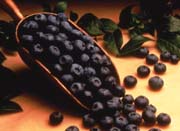
The point is that even though these two programs promote different products, their overall objectives are the same-get Americans to eat more of the foods directly correlated with improving health. Indeed, in recent years fruits, vegetables and dairy foods have been making headlines for the many "functional" benefits they provide, benefits beyond contributing to everyday nutrition.
Most of us have a clear idea of what is so special about dairy. Here are a few good words about fruit, which is the perfect complement to dairy in the increasingly popular categories of drinkable yogurts and dairy-based smoothies.
Fruits contain naturally occurring antioxidants such as vitamins A, C and E, and anthocyanins. Antioxidants are important in the diet because they help neutralize harmful byproducts of metabolism called free radicals, which can lead to cancer and other age-related diseases. Antioxidant-rich diets are particularly attractive to aging boomers, who want to defy the aging process (See this month's Tools for Innovation supp-lement for more information on formulating foods for this important, and quite large, consumer segment.)
Strong-colored berries such as red raspberries and blueberries are recognized as being particularly con-centrated sources of antioxidants thanks to the high levels of the colorants called anthocyanins. In fact, researchers at the USDA Human Nutrition Center (HNRCA) have found that blueberries rank No. 1 in antioxidant activity when compared to 40 other fresh fruits and vegetables.

A number of studies in Europe have documented the relationship between bilberries, the European cousin of blueberries and improved eyesight. This is thought to occur because of the anthocyanin in the blue pigment, which is also available in the blueberry. One study in Japan documented that blueberries helped ease eye fatigue.
With the functional beverage market being one of the today's fastest growing product categories, it makes sense for 5-A-Day and 3-A-Day to, literally, "blend" their wares, providing consumers with a serving of both fruit and milk in one grab-and-go bottle.
When it comes to formulating with berries, the forms most applicable for dairy-based beverage application are 100% juice and 100% puree. Both provide a range of consistencies that have application in beverages, and both provide real fruit color, flavor and sweetness.
Blueberry juice, in particular, contains about 12% sugar, and has a low acid content of about 1.9%. With this sugar/acid ratio, blueberry ingredients help remove the sour taste associated with cultured dairy products.
Some berries are high in pectin and can cloud and gel in beverage products. To overcome this, suppliers will often treat the berry juice with an enzyme.
The dairy industry has an opportunity to show 5-A-Day that we want to work with them, not against them, by formulating functional dairy beverages using fruit. In turn, the dairy industry can capitalize on the powerful, positive science-based health messages about fruit, berries in particular.